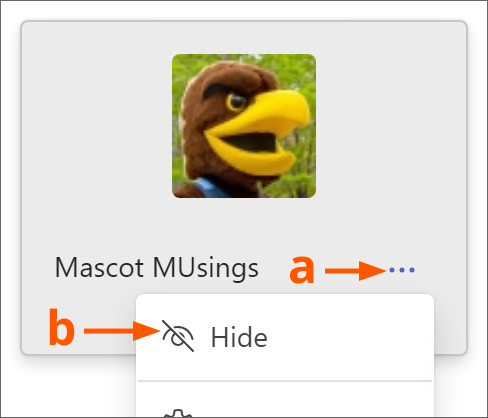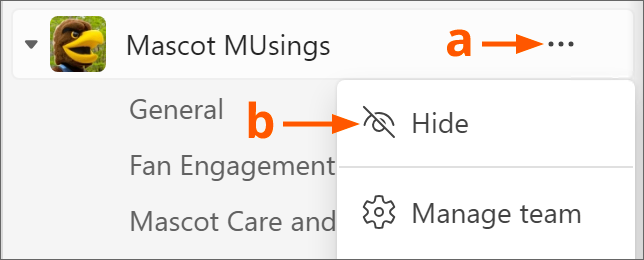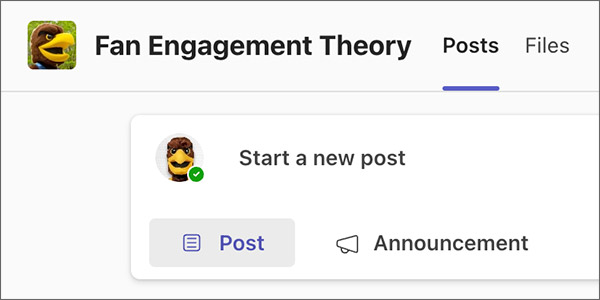Using Teams Sites and Teams Channels
A Microsoft Teams site is a collection of channels. With channels, you collaborate on a topic through meetings, posts, and uploaded files.
Creating and Using Teams Sites
If you have a group that's already a part of a Teams site, a site member can create a new channel within the Teams site. For instructors, IT Services automates Teams site creation for your courses. See "Use CheckMarq to Control Microsoft Teams Sites for Courses." But if you have a unique group of collaborators, learn how to create a new Teams site.
Customize Your View of Teams Sites
From Microsoft Teams, select Teams icon in the left vertical toolbar. Your Teams sites appear either as a grid or a column list. To switch from grid view to list view or vice versa, follow these steps.
- In Teams, on the topmost window bar, locate the three-dots menu icon in the upper right. Select Three-dots menu icon > Settings.

- The Teams Settings screen appears. In the left column, select Appearance and Accessibility.
- The "Appearance and Accessibility" screen loads. In the Layout section, select List to see your Teams sites in a left-column list. Or select Grid to view your sites as a grid.
- From the Teams left vertical toolbar, select the Teams icon. Your new view of Teams sites appears.
Hide Less Used Teams Sites
- If your Teams sites display as a grid, follow these steps to hide the Teams site.
- Click or tap the three-dots menu icon on the Teams site tile.
- Select Hide. The Teams site moves to the "Hidden" section.

- If your Teams sites display as a list, follow these steps to hide the Teams site.
- Click or tap the three-dots menu icon on the Teams site list row.
- Select Hide. The Teams site moves to the "Hidden" section.

Using Teams Channels
Channels make up in a Teams site; think of channels as focused topics. Every Teams site has a default "General" channel. Members can meet in a channel; post and reply to channel conversations; and upload and share files. Microsoft Teams offers three kinds of channels: standard, shared, and private. See "Create a standard, private, or shared channel in Microsoft Teams."
Posting in Channels
When you visit a channel, the Posts tab appears first. Here you'll find conversations about the channel topic. As a channel member, you can select the Post button to compose a new message for the channel. Or select the Announcement button to include a headline and/or image for your message.

When your post or announcement is ready, click or tap the Post button.
Replying in Channels
Channel members reply to posts and announcements by selecting the Reply link. Write your reply and click or tap the Send button. Replies to a post or announcement make up a threaded conversation. An active channel has many threaded conversations in the Post tab.
Mentions in Channel Conversations
Posting or replying to a channel conversation may not be enough. Not every channel member receives notifications on all channel activity. To call someone's attention in a channel post, announcement, or reply, @mention them. Type @ before typing their name. Then select them from the menu that appears. They receive a notification. From the notification, they can jump into the conversation at the mention. To get the attention of more than one channel member, try these @mentions.
- Type @{team name} to notify everyone on in Teams site (e.g., @Mascot MUsings)
- Type @{channel name} to notify everyone in that channel (e.g., @general)
- Type @{tag} to notify the subset of channel members in a tag (e.g., @managers)
Meeting in Channels
You can also hold a Teams meeting in a channel. Channel meetings can be instantaneous. In the upper right, select the camera icon. A drop-down menu appears. Select Meet now. The Teams meeting begins, and any member of the channel can join immediately. Or you can schedule channel meetings.
Channel Notifications
Looking fine-tune how and when you receive notification about a channel's activity? On the Teams channel, select the three-dots menu icon to reveal a drop-down menu. From the menu, choose Channel notifications. See "Customize channel notifications in Microsoft Teams" to customize your notification settings.